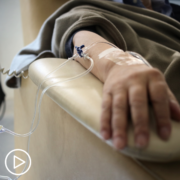Understanding AML Induction and Consolidation Therapy
Understanding AML Induction and Consolidation Therapy from Patient Empowerment Network on Vimeo.
Dr. Hetty Carraway, an AML specialist at Cleveland Clinic, provides an explanation of the role of induction and consolidation therapy in AML patients.
Dr. Hetty Carraway is Director of the Leukemia Program at Cleveland Clinic. Dr. Carraway cares for patients with acute leukemia and bone marrow failure states. Learn more about Dr. Carraway, here.
Related Resources:
Transcript:
Katherine:
Would you define induction therapy and consolidation therapy and tell us what the differences are?
Dr. Carraway:
For most patients that are diagnosed with an acute myeloid leukemia, over the last 30 to 40 years we’ve used an intensive chemotherapy regimen that we call induction. Induction means that we’re trying to get the leukemia into remission with an intensive chemotherapy regimen. Classically, that has been two agents; one, a cytarabine based regimen along with an anthracycline, either idarubicin, danorubicin, or some anthracycline that’s similar.
Now, the cytarabine based therapy is a continuous infusion over seven days. The anthracycline is given over three days as an intravenous IV push, and so that’s why it’s kind of been nicknamed seven and three – seven days of cytarabine and three days of another anthracycline.
Now, that has constituted the induction intensive regimen in the hospital with the idea that that leukemia gets under control and goes away. More recently for patients, they can receive therapy that is not this inpatient, in-hospital, induction chemotherapy but rather use oral therapy combining with venetoclax, which is a Bcl-2 inhibitor, along with azacitidine, which is either IV or subcutaneous given to patients over seven days. The oral, venetoclax is every day.
That type of induction can also be given and is now an outpatient regimen and more often offered to patients that are older, over the age of 75.
That, too can be considered induction with the idea that once a patient is diagnosed with leukemia this regimen is started, and after one month or even two months on venetoclax plus azacitidine patients’ leukemia can get into what we call remission, where the blast percentages are less than 5 percent. Then, normal hematopoiesis of platelets being greater than 100,000 and a neutrophil count greater than 500 or 1,000, and the patient is then transfusion-independent.
In general, induction chemotherapy is that first round of chemotherapy that’s trying to get the leukemia under control.
Consolidation chemotherapy is when you use subsequent cycles of chemotherapy to keep the leukemia under control because we know that if we don’t continue to give some continuation of therapy that the small, little seeds of leukemia will re-emerge and leukemia will relapse.






